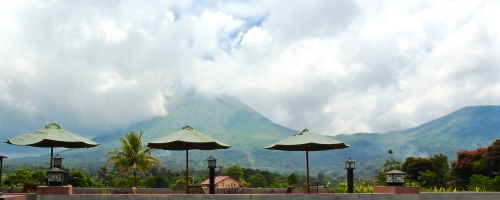After a long morning of sightseeing in the Minahasa Highlands and a much needed pit-stop for lunch in Tomohon, we continued with the rest of our tour.
Woloan Village
Our first stop post-lunch was the world famous village of Woloan, which lies a couple of kilometers to the west of Tomohon. Here, skilled carpenters build traditional wooden houses that can easily be knocked down and reassembled at a different location (IKEA customers – sounds familiar, right?!). These sturdy, prefabricated houses are shipped all over the world and the main street of the village is lined with sample houses for customers to choose from. Despite the knock-down design, these houses are earthquake proof. Says something about the superlative design and expert craftsmanship!
By this point in the afternoon, I was wishing one of these show houses had a bed, so I could take a quick nap!
Lake Linow
About 3km west of Tomohon, lies the remarkable Lake Linow. The name ‘Linow’ comes from the Minahasa word ‘Lilinowan’, which means ‘the gathering place of water’. This lake is a water filled, volcanic crater that changes colour over the course of the day, from shades of deep green to bright blue tones.
Of course, there is a logical explanation for this phenomenon. Small vents in the ground surface of the lake (both above and below the water level) emit volcanic gases like sulphur dioxide, hydrogen sulfide etc. The minerals in the water, combined with the reflection-refraction of sunlight, cause the lake to change colour. The volcanic gases also give the area a distinct ‘rotten egg’ smell.

The colour changing waters of Lake Linow. A couple of active steam vents can be seen in the background
Much to my relief, there was a small café by the lake and the caffeine shot was very welcome! 🙂
Watu Pinawatengan
Refreshed by the caffeine infusion, we headed to a site of great cultural significance to the Minahasa people – the irregularly shaped boulder of ‘Watu Pinawatengan’. The name loosely translates to ‘stone of the discussion about sharing’.
According to some historians, in 670 CE, the various Minahasa tribes met at this stone to discuss the division of the land among them. The hieroglyphs inscribed on the stone are said to reflect this agreement. This lead to the formation of a community of independent states, which in case of an external enemy attack, would unite to defend the land.
Pulutan, Pottery Village
Our final stop for the day was Pulutan village, famous for its pottery artisans and ceramic wares.
Lake Tondano
Lastly, I must mention Lake Tondano, the largest lake in North Sulawesi, also created by volcanic activity. We passed this lake from a distance, on our journey into the Minahasa Highlands, and back.
Once visited by the great British naturalist, Alfred Russel Wallace, during his time in Sulawesi (Jun -Sep 1859); Lake Tondano is today a popular tourist destination, with several seafood restaurants located around the lake.
At the end of this culturally rich day, I was wishing I had a lot more time to appreciate all the details and nuances. I guess, I’ll just have to read about it or may be I could start planning our return to North Sulawesi 😉
Our thanks to the team at Lembeh Resorts for organizing this fabulous day trip







































